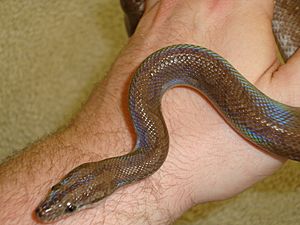Epicrates maurus facts for kids
Quick facts for kids Epicrates maurus |
|
|---|---|
 |
|
| Colombian rainbow boa | |
| Conservation status | |
| Scientific classification | |
| Genus: |
Epicrates
|
| Species: |
maurus
|
| Synonyms | |
The Epicrates maurus is a type of snake that is not venomous. It is known as the brown rainbow boa. These snakes are found in the Amazon region of South America. They belong to the family Boidae, which includes other boas.
Brown rainbow boas spend time both on the ground and climbing trees. They can also swim well. These snakes are active at night, especially in the middle of the night. Their scales have a beautiful iridescent shine, like a rainbow, when sunlight hits them.
About the Brown Rainbow Boa
Size and Appearance
The Epicrates maurus is the smallest of the rainbow boas. They usually grow to be 3 to 5 feet long. However, their size can change depending on the specific type. For example, the Colombian rainbow boa (E. m. colombianus) can grow to 5–6 feet long. It takes them about 4–6 years to become fully grown.
Female brown rainbow boas are much larger than males. They are longer and thicker. This difference between males and females is called sexual dimorphism.
Colors and Patterns
These snakes are usually brown. They have large, dark-edged rings on their backs. These rings often have lighter centers, forming saddle-like shapes. Sometimes, you might see a slight 'S' pattern on their bodies.
Rainbow boas can change their color from day to night. This process is called metachrosis. At night, their patterns become lighter, almost silver. Their sides and bottom may also look silver and mottled.
Sometimes, snakes are born with unusual colors or patterns. For example, some have albinism, which means they lack color. These snakes are very rare in the wild. However, they are often found in captivity, where people breed them for these special colors.
These pictures show how the same snake can change color from day to night. The photos were taken just over three hours apart.
Where They Live
This type of rainbow boa lives in the northern parts of its range. You can find them in rainforests and drier open areas. Their homes include southern Central America, Trinidad and Tobago, and northern South America.
When they are young, Colombian rainbow boas often climb trees and bushes. They do this to find food and to hide from animals that might hunt them. As they get older, they tend to stay more on the ground.
Behavior
Colombian rainbow boas are not venomous. They catch their prey by constriction. This means they wrap their bodies around an animal and squeeze it until it cannot breathe. Like most boas, they have special pits on their faces. These pits help them sense the body heat of warm-blooded animals. This helps them hunt in the dark.
Even though they are active at night, they might warm themselves in the sun during the day. This happens when the night temperatures are very low. They hunt at dawn and dusk. They eat small mammals like mice, birds, and lizards. Their heat-sensing pits are very useful for hunting when there is not much light.
Most Colombian rainbow boas do not need to eat anything larger than a big rat. Like all snakes, they can open their jaws very wide. This allows them to swallow prey that seems much bigger than their mouths.
Wild Colombian rainbow boas might bite if they feel scared. This bite can hurt, but it is not dangerous. Still, it is important to clean the bite to prevent infection. When snakes are shedding their skin, they can be more easily annoyed. This is because shedding is stressful, and their sight might be blurry.
Reproduction and Life Cycle
Colombian rainbow boas usually live alone. They only come together to mate. Male boas can mate with several females. Females give birth to live young. This is called being ovoviviparous. The babies grow inside the mother's body. This means the mother puts a lot of energy into her young. The babies develop in a safe, warm place and get nutrients from their mother. When they are born, the young snakes are fully developed. They can take care of themselves right away.
Special Way of Reproduction
Snakes almost always reproduce by mating with a male and a female. However, scientists recently found something amazing about E. maurus. They discovered that a female can sometimes have babies without a male. This is called facultative parthenogenesis. It means the female can reproduce by herself.
In these rare cases, the female snake can produce only female babies. These babies are like clones of the mother. This is only the third time scientists have confirmed this type of "virgin birth" in snakes.
Living in Captivity
Brown rainbow boas do very well when kept as pets. Many people think they are the easiest rainbow boa species to care for. Their care is similar to the Brazilian rainbow boa. However, they prefer slightly cooler temperatures and can handle less humidity.
They mostly eat mice and rats. But they can also eat other small rodents or birds that are the right size. When they are young, they might be a bit shy or try to bite. But with regular handling, they usually become very calm and friendly.
The species Epicrates cenchria (the rainbow boa) and E. maurus colombianus (the Colombian rainbow boa) are becoming more popular as pets. Many are bred in captivity, so very few are taken from the wild. Breeders try to create snakes with different colors and patterns. These are called "morphs." They do this by carefully breeding snakes with certain genes. These genes control the colors and patterns of the snake's scales.
See also
 In Spanish: Boa Tornasol para niños
In Spanish: Boa Tornasol para niños
Images for kids






